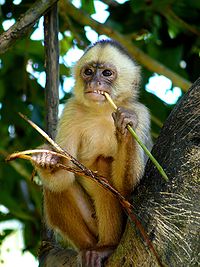

| Cebidae [2][3] Temporal range: Late Oligocene[1] to present | |
|---|---|

| |
| Panamanian white-faced capuchin (Cebus imitator) | |
| Scientific classification | |
| Domain: | Eukaryota |
| Kingdom: | Animalia |
| Phylum: | Chordata |
| Class: | Mammalia |
| Order: | Primates |
| Suborder: | Haplorhini |
| Infraorder: | Simiiformes |
| Parvorder: | Platyrrhini |
| Family: | Cebidae Bonaparte, 1831 |
| Type genus | |
| Cebus Erxleben, 1777 | |
| Genera | |
The Cebidae are one of the five familiesofNew World monkeys now recognised. Extant members are the capuchin and squirrel monkeys.[3] These species are found throughout tropical and subtropical South and Central America.
Cebid monkeys are arboreal animals that only rarely travel on the ground. They are generally small monkeys, ranging in size up to that of the brown capuchin, with a body length of 33 to 56 cm, and a weight of 2.5 to 3.9 kilograms. They are somewhat variable in form and coloration, but all have the wide, flat, noses typical of New World monkeys.
They are omnivorous, mostly eating fruit and insects, although the proportions of these foods vary greatly between species. They have the dental formula:2.1.3.2-32.1.3.2-3
Females give birth to one or two young after a gestation period of between 130 and 170 days, depending on species. They are social animals, living in groups of between five and forty individuals, with the smaller species typically forming larger groups. They are generally diurnal in habit.[4]
Previously, New World monkeys were divided between Callitrichidae and this family. For a few recent years, marmosets, tamarins, and lion tamarins were placed as a subfamily (Callitrichinae) in Cebidae, while moving other genera from Cebidae into the families Aotidae, Pitheciidae and Atelidae.[2] The most recent classification of New World monkeys again splits the callitrichids off, leaving only the capuchins and squirrel monkeys in this family.[3]

|
Extant primate families
| |||||||||||||
|---|---|---|---|---|---|---|---|---|---|---|---|---|---|
| |||||||||||||
| Strepsirrhini |
| ||||||||||||
| Haplorhini |
| ||||||||||||
|
| |||||||||||||||||||||||||||||||||||||||||||||
|---|---|---|---|---|---|---|---|---|---|---|---|---|---|---|---|---|---|---|---|---|---|---|---|---|---|---|---|---|---|---|---|---|---|---|---|---|---|---|---|---|---|---|---|---|---|
| |||||||||||||||||||||||||||||||||||||||||||||
| |||||||||||||||||||||||||||||||||||||||||||||
| |||||||||||||||||||||||||||||||||||||||||||||
| |||||||||||||||||||||||||||||||||||||||||||||
| |||||||||||||||||||||||||||||||||||||||||||||
| Cebidae |
|
|---|---|
| Authority control databases: National |
|
|---|